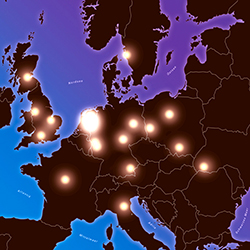URL: https://physikseminar.desy.de/zeuthen/past_colloquia/colloquia_in_2016/january_13_2016/@@siteview
Breadcrumb Navigation
LOFAR – The Low-Frequency Array: from ultra-high Energy Cosmic Rays to the early Universe
Heino Falcke (Radboud University, Nijmegen | ASTRON, Dwingeloo)
Seminar room 3, 15:00
The International LOFAR Telescope (ILT) is an innovative low-frequency radio telescope, providing and order of magnitude improvement in this little explored frequency range.
Digital technology, a broad fractional bandwidth, and high sensitivity make it a rather versatile telescope addressing a wide range of science. One important science goal is to detect the first generation of black holes and galaxies in the universe during the epoch of reionization and to study hydrogen formed after the big bang. LOFAR is also an ideal system to discover transient and sporadic radio signals.
Already now LOFAR has made some of the deepest radio images ever made at these low-frequencies, detecting thousands of radio sources per field in a few hours and revealing, e.g., an easily identifiable population of the most powerful radio galaxies at z>1. Transient searches have begun, pulsar observations challenge standard pulsar emission models, and observations of nanosecond-scale radio flashes from airshowers allow to accurately measure energy and composition of high-energy cosmic rays. The first results of LOFAR promise a bright future for the new generation of radio telescopes, currently being developed, which eventually should culminate in the Square Kilometre Array (SKA).





